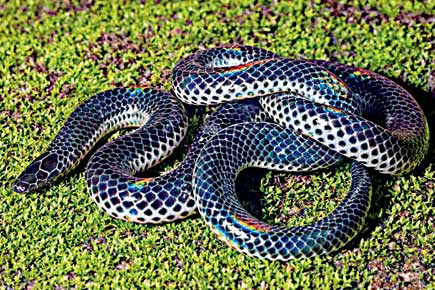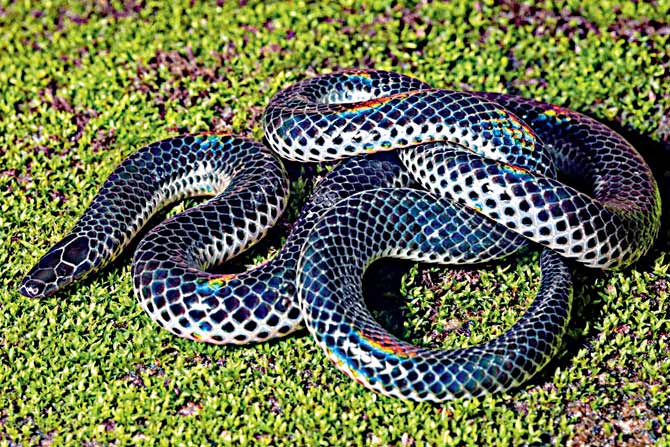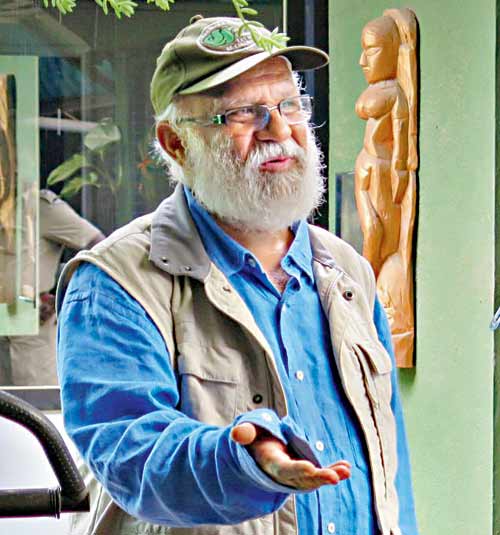The discovery of the new burrowing snake – named after well known herpetologist Neelam Kumar Khaire - in the biological hotspot comes after 144 years

In a major achievement, researchers have discovered a new species of burrowing snake in the biological hotspot of the northern Western Ghats, after a gap of 144 years. The snake has been named after well known herpetologist from Maharashtra, Neelam Kumar Khaire, as Melanophidium Khairei. The research paper about it has been published in the scientific journal, Zootaxa recently.

Melanophidium Khairei, ‘Khaire’s Black Shieldtail, named after Dr Neelam Kumar Khaire, who founded the Katraj Snake Park and the Indian Herpetological Society. Pic/Varad Giri
Speaking to mid day, researcher and post doctoral fellow from the National Centre for Biological Sciences, Varad Giri said, “We are happy to announce that our team of researchers have discovered a new species of burrowing snake of the genus Melanophidium from the northern Western Ghats of India after a gap of 144 years. This snake belongs to the family Uropeltidae, and all species in this group are burrowers and live mostly underground.”

Khaire
Scientists from the Natural History Museum (NHM), London, collaborated with scientists from the National Centre for Biological Sciences (NCBS), Bangalore, The Indian Herpetological Society (IHS), Pune, and the Bombay Natural History Society (BNHS) for the research. The new discovery is the outcome of meticulous efforts of 15 years by the research paper’s main author Dr David Gower from the NHM, and Dr Mark Wilkinson of the NHM, Dr Varad Giri of NCBS and Ashok Captain of IHS/BNHS.
“We have befittingly named the new species after Neelam Kumar (Anna) Khaire, in recognition of his contribution to the knowledge, appreciation and conservation of snakes in India,” added Giri.
Khaire’s Black Shieldtail
It is a highly iridescent burrowing snake that inhabits evergreen forests and is rarely seen above ground. It eats earthworms and is believed to bear young as mammals. It’s presently known in a few locations in southern Maharashtra, Goa and northern Karnataka. It is a small snake - the largest known specimen is 550mm in length. It is non-venomous.
Chance discovery
The new burrowing snake would not have been discovered but for the visit of Dr David Gower to the BNHS museum. He realized the specimens of the species in the BNHS were wrongly identified.
“The genus Melanophidium, commonly referred as ‘Black Shieldtail’, is endemic to the Western Ghats and three species were previously known. Dr Gower observed the first specimens of this species in the collections of the BNHS, during his visit to their museum in 2001. However, they were wrongly identified as Melanophidium Punctatum, commonly called the Pied-bellied Shieldtail. He realized that the specimens in BNHS were a distinct species,” said a researcher.
After the additional contributions based on fresh field surveys by Dr Varad Giri and Ashok Captain, and taxonomic inputs from Dr Wilkinson, it was proved that the snake is a distinct new species.
 Subscribe today by clicking the link and stay updated with the latest news!" Click here!
Subscribe today by clicking the link and stay updated with the latest news!" Click here!









